Characterization of the Solution of the Seismic Source Mechanism in Southeastern Sichuan
Abstract
1. Introduction
2. Geological Settings
3. Moment Tensor Inversion
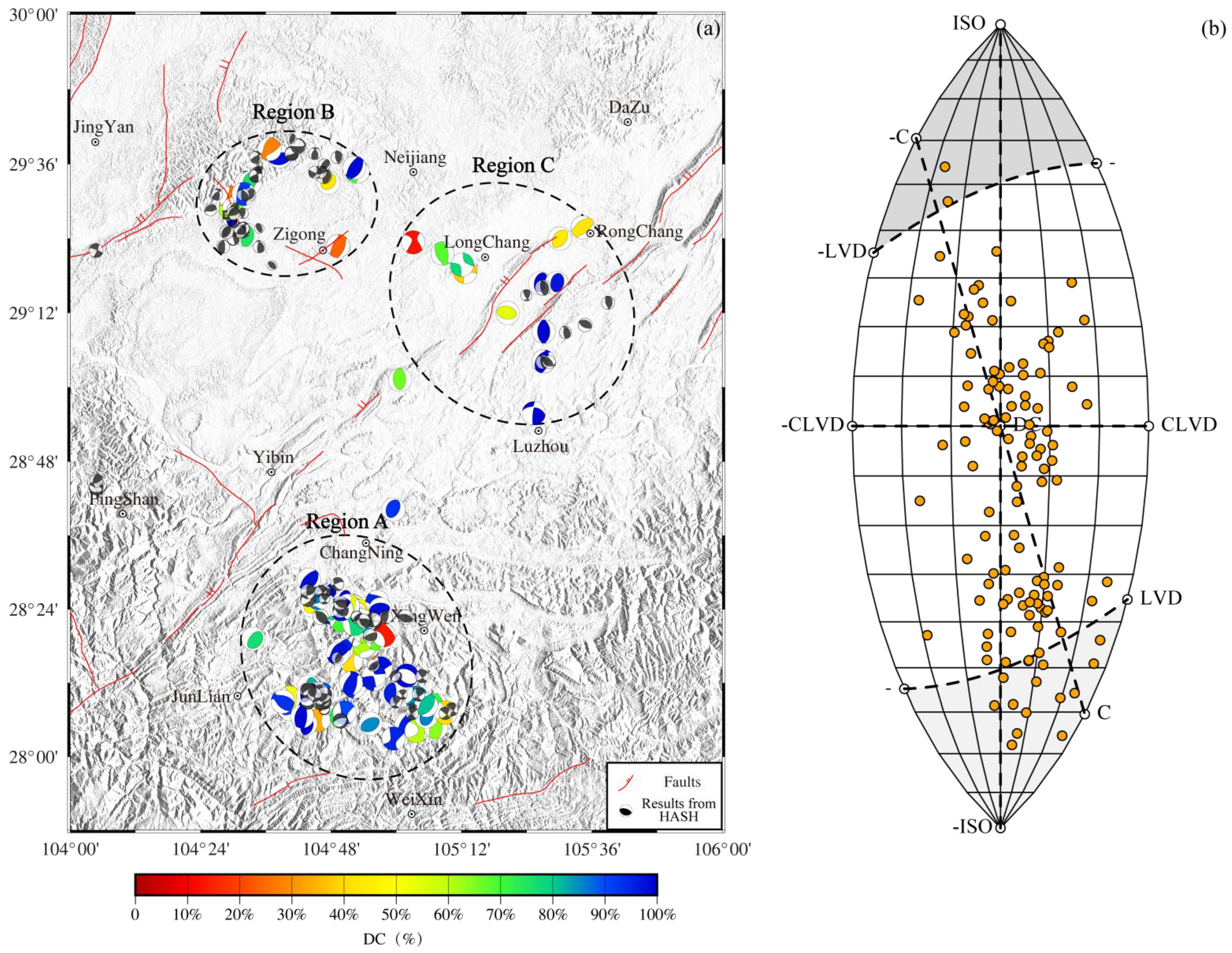
4. Stress Field Inversion
4.1. Focal Mechanism Types
4.2. Stress Field Spatial Characteristics
4.3. Mohr Circles
5. Discussion
6. Conclusions
- (1)
- The seismic activity in the southeastern Sichuan region is predominantly characterized by double-couple (DC) mechanisms, indicating that shear faulting is the primary mode of fault movement, consistent with the typical features of tectonic earthquakes. However, some earthquake events still exhibit non-double-couple components, particularly negative isotropic (ISO) components. This is speculated to be related to fluid intrusion caused by hydraulic fracturing and water injection activities during shale gas extraction.
- (2)
- The focal mechanism solutions in the southeastern Sichuan region predominantly exhibit thrust faulting patterns (approximately 51%), followed by strike-slip mechanisms (about 11%), with normal faulting representing a minor proportion (around 7%). The remaining solutions correspond to mixed-type mechanisms. Significant spatial heterogeneity characterizes the distribution of seismic mechanism types. In region A, thrust and strike-slip mechanisms dominate while minor normal faulting and mixed-type solutions coexist. Region B primarily features thrust faulting with subordinate normal faulting components. Region C consists mainly of thrust-faulting earthquakes accompanied by occasional strike-slip events. The complexity of these mechanism solutions primarily reflects the involvement of multiple faults in seismic rupture processes rather than single or limited fault systems in the southeastern Sichuan region.
- (3)
- The stress field in southeastern Sichuan, determined through seismic focal mechanism solutions, demonstrates fundamental consistency in orientation across subregions, predominantly governed by near-horizontal compressional stress with thrust faulting as the principal seismogenic structure. Regional variations nevertheless emerge in stress orientations: the σ1 axis in the northern segment (Region B) trends WNW-ESE, aligning with both the principal compressive stress field of the Sichuan Basin and GNSS station velocity vectors, whereas the southern segment (Region A) exhibits an E-W oriented σ1 axis displaying counterclockwise rotation relative to the background principal compressive stress field. This rotational pattern indicates that superimposed perturbations on the regional stress field have modified local stress orientations in Area A.
- (4)
- The inversion of Mohr circles using STRESSINVERSE software (Version 1.1.3) for subregions in southeastern Sichuan reveals that Areas A and B possess similar stress shape ratios and fault plane distributions. However, Region A exhibits a relatively higher proportion of fault planes located within Mohr circles compared to Region B. This observation indicates that Region B demonstrates higher levels of fault instability, whereas the initiation of fault ruptures in Region A is primarily controlled by pore pressure effects.
Author Contributions
Funding
Institutional Review Board Statement
Informed Consent Statement
Data Availability Statement
Acknowledgments
Conflicts of Interest
References
- Burchfiel, B.C.; Royden, L.H.; Van Der Hilst, R.D.; Hager, B.H.; Chen, Z.; King, R.W.; Li, C.; Lü, J.; Yao, H.; Kirby, E. A geological and geophysical context for the Wenchuan earthquake of 12 May 2008, Sichuan, People’s Republic of China. GSA Today 2008, 18, 4–11. [Google Scholar] [CrossRef]
- Zhang, P.Z.; Xu, X.W.; Wen, X.Z.; Ran, Y.K. Slip Rates and Recurrence Intervals of the Longmen Shan Active Fault Zone, and Tectonic Implications for the Mechanism of the May 12 Wenchuan Earthquake, 2008, Sichuan, China. Chin. J. Geophys. 2008, 51, 1066–1073. (In Chinese) [Google Scholar]
- Lei, X.; Wang, Z.; Su, J. The December 2018 ML 5.7 and January 2019 ML 5.3 earthquakes in South Sichuan Basin induced by shale gas hydraulic fracturing. Seismol. Res. Lett. 2019, 90, 1099–1110. [Google Scholar] [CrossRef]
- Lei, X.; Su, J.; Wang, Z. Growing seismicity in the Sichuan Basin and its association with industrial activities. Sci. China Earth Sci. 2020, 63, 1633–1660. [Google Scholar] [CrossRef]
- Yi, G.X.; Long, F.; Liang, M.J.; Zhao, M.; Wang, S.W.; Gong, Y.; Qiao, H.Z.; Su, J.R. Focal mechanism solutions and seismogenic structure of the 17 June 2019 MS6.0 Sichuan Changning earthquake sequence. Chin. J. Geophys. 2019, 62, 3432–3447. (In Chinese) [Google Scholar] [CrossRef]
- Yi, G.X.; Long, F.; Liang, M.J.; Zhao, M.; Wang, S.W. Geometry and tectonic deformation of seismogenic structures in the Rongxian-Weiyuan-Zizhong region, Sichuan Basin: Insights from focal mechanism solutions. Chin. J. Geophys. 2020, 63, 3275–3291. (In Chinese) [Google Scholar] [CrossRef]
- Yi, G.X.; Zhao, M.; Long, F.; Liang, M.J.; Wang, M.M.; Zhou, R.J.; Wang, S.W. Characteristics of the seismic sequence and seismogenic environment of the MS6.0 Sichuan Luxian earthquake on September 16, 2021. Chin. J. Geophys. 2021, 64, 4449–4461. (In Chinese) [Google Scholar] [CrossRef]
- GB 18306-2015; General Administration of Quality Supervision, Inspection and Quarantine of the People’s Republic of China (AQSIQ); Standardization Administration of China (SAC). Seismic Ground Motion Parameter Zonation Map of China; Standards Press of China: Beijing, China, 2015. (In Chinese)
- Shao, Z.G. Earthquake Cases in China (Volume for Year 2019); Seismological Press: Beijing, China, 2022. (In Chinese) [Google Scholar]
- Li, P.P.; Jiang, P.; Li, T.L.; Ma, K.X.; Wen, R.Z.; Su, J.R.; Jiang, W.S. The strong ground motion characteristics of MS6.0 Luxian, Sichuan, earthquake on 16 September 2021. Acta Seismol. Sin. 2022, 44, 260–270. (In Chinese) [Google Scholar] [CrossRef]
- King, G.C.P.; Stein, R.S.; Lin, J. Static stress changes and the triggering of earthquakes. Bull. Seismol. Soc. Am. 1994, 84, 935–953. [Google Scholar]
- Stein, R.S. The role of stress transfer in earthquake occurrence. Nature 1999, 402, 605–609. [Google Scholar] [CrossRef]
- Harris, R.A. Introduction to special section: Stress triggers, stress shadows, and implications for seismic hazard. J. Geophys. Res. Solid Earth 1998, 103, 24347–24358. [Google Scholar] [CrossRef]
- Toda, S.; Lin, J.; Meghraoui, M.; Stein, R.S. 12 May 2008 M = 7.9 Wenchuan, China, earthquake calculated to increase failure stress and seismicity rate on three major fault systems. Geophys. Res. Lett. 2008, 35, L17305. [Google Scholar] [CrossRef]
- Parsons, T.; Ji, C.; Kirby, E. Stress changes from the 2008 Wenchuan earthquake and increased hazard in the Sichuan basin. Nature 2008, 454, 509–510. [Google Scholar] [CrossRef]
- Qian, Q.; Han, Z.Z. The research in the change of the earthquake occurrence probability in Longquan Shan fault after the Wenchuan earthquake. Prog. Geophys. 2011, 26, 489–497. (In Chinese) [Google Scholar] [CrossRef]
- Meng, L.; McGarr, A.; Zhou, L.; Zang, Y. An investigation of seismicity induced by hydraulic fracturing in the Sichuan Basin of China based on data from temporary seismic network. Bull. Seismol. Soc. Am. 2019, 109, 348–357. [Google Scholar] [CrossRef]
- Lei, X.; Huang, D.; Su, J.; Jiang, G.; Wang, X.; Wang, H.; Guo, X.; Fu, H. Fault reactivation and earthquakes with magnitudes of up to Mw4.7 induced by shale-gas hydraulic fracturing in Sichuan Basin, China. Sci. Rep. 2017, 7, 7971. [Google Scholar] [CrossRef]
- Long, F.; Du, F.; Ruan, X.; Deng, Y.; Zhang, T. Water injection triggered earthquakes in the Zigong mineral wells in ETAS model. Earthq. Res. China 2010, 26, 164–171. (In Chinese) [Google Scholar]
- Ellsworth, W.L. Injection-induced earthquakes. Science 2013, 341, 1225942. [Google Scholar] [CrossRef]
- Schultz, R.; Atkinson, G.; Eaton, D.W.; Gu, Y.J.; Kao, H. Hydraulic fracturing volume is associated with induced earthquake productivity in the Duvernay play. Science 2018, 359, 304–308. [Google Scholar] [CrossRef]
- Geological Society of Korea. Summary Report on Pohang Earthquake; Geological Society of Korea: Seoul, Republic of Korea, 2019; Available online: https://www.gskorea.or.kr/custom/27/data/Summary_Report_on_Pohang_Earthquake_March_20_2019.pdf (accessed on 9 February 2025).
- Lavecchia, G.; de Nardis, R.; Costa, G.; Tiberi, L.; Ferrarini, F.; Cirillo, D.; Brozzetti, F.; Suhadolc, P. Was the Mirandola thrust really involved in the Emilia 2012 seismic sequence (northern Italy)? Implications on the likelihood of triggered seismicity effects. Bull. Geophys. Theor. Appl. 2015, 56, 461–488. [Google Scholar] [CrossRef]
- Molnar, P.H.; Tapponnier, P. Cenozoic tectonics of Asia: Effects of a continental collision. Science 1975, 189, 419–426. [Google Scholar] [CrossRef]
- Yin, A.; Harrison, T.M. Geologic evolution of the Himalayan-Tibetan orogen. Annu. Rev. Earth Planet. Sci. 2000, 28, 211–280. [Google Scholar] [CrossRef]
- Chen, S.F.; Wilson, C.; Deng, Q.D.; Zhao, X.L.; Zhi, L.L. Active faulting and block movement associated with large earthquakes in the Min Shan and Longmen Mountains, northeastern Tibetan plateau. J. Geophys. Res. 1994, 99, 24025–24038. [Google Scholar] [CrossRef]
- Burchfiel, B.C.; Chen, Z.L.; Liu, Y.; Royden, L.H. Tectonics of the Longmen Shan and adjacent regions, Central China. Int. Geol. Rev. 1995, 37, 661–735. [Google Scholar] [CrossRef]
- Kirby, E.; Reiners, P.W.; Krol, M.A.; Whipple, K.X.; Hodges, K.V.; Farley, K.A.; Tang, W.; Chen, Z. Late Cenozoic evolution of the eastern margin of the Tibetan Plateau: Inferences from 40Ar/39Ar and (U-Th)/He thermochronology. Tectonics 2002, 21, 1001. [Google Scholar] [CrossRef]
- Xiong, X.S.; Gao, R.; Guo, L.H.; Wang, H.Y.; Jiang, W.W. The deep structure feature of the Sichuan Basin and adjacent orogens. Acta Geol. Sin. 2015, 89, 1153–1164. [Google Scholar] [CrossRef]
- Zhang, P.Z.; Shen, Z.; Wang, M.; Gan, W.; Bürgmann, R.; Molnar, P.; Wang, Q.; Niu, Z.; Sun, J.; Wu, J.; et al. Continuous deformation of the Tibetan Plateau from global positioning system data. Geology 2004, 32, 809–812. [Google Scholar] [CrossRef]
- Wang, M.; Shen, Z.K. Present-day crustal deformation of continental China derived from GPS and its tectonic implications. J. Geophys. Res. Solid Earth 2020, 125, e2019JB018774. [Google Scholar] [CrossRef]
- Bureau of Geology and Mineral Resources of Sichuan Province. Regional Geology of Sichuan Province; Geological Publishing House: Beijing, China, 1991. (In Chinese) [Google Scholar]
- Guo, Z.W.; Deng, K.L.; Han, Y.H. Formation and Evolution of the Sichuan Basin; Geological Publishing House: Beijing, China, 1996. (In Chinese) [Google Scholar]
- Jost, M.L.; Herrmann, R.B. A student’s guide to and review of moment tensors. Seismol. Res. Lett. 1989, 60, 37–57. [Google Scholar] [CrossRef]
- Aki, K.; Richards, P.G. Quantitative Seismology: Theory and Methods, 2nd ed.; University Science Books: Sausalito, CA, USA, 2002; ISBN 978-0935702965. [Google Scholar]
- McGarr, A. An implosive component in the seismic moment tensor of a mining-induced tremor. Geophys. Res. Lett. 1992, 19, 1579–1582. [Google Scholar] [CrossRef]
- Frohlich, C. Earthquakes with Non-double-couple Mechanisms. Science 1994, 264, 804–809. [Google Scholar] [CrossRef] [PubMed]
- Ross, A.; Foulger, G.R.; Julian, B.R. Non-Double-Couple Earthquake Mechanisms at the Geysers Geothermal Area, California. Geophys. Res. Lett. 1996, 23, 877–880. [Google Scholar] [CrossRef]
- Dreger, D.S.; Ford, S.R.; Walter, W.R. Source Analysis of the Crandall Canyon. Science 2008, 321, 217–219. [Google Scholar] [CrossRef]
- Evans, K.F.; Zappone, A.; Kraft, T.; Deichmann, N.; Moia, F. A survey of the induced seismic responses to fluid injection in geothermal and CO2 reservoirs in Europe. Geothermics 2012, 41, 30–54. [Google Scholar] [CrossRef]
- Wang, R.; Gu, Y.J.; Schultz, R.; Zhang, M.; Kim, A. Faults and non-double-couple components for induced earthquakes. Geophys. Res. Lett. 2018, 45, 8966–8975. [Google Scholar] [CrossRef]
- Zhu, L.; Ben-Zion, Y. Parametrization of general seismic potency and moment tensors for source inversion of seismic waveform data. Geophys. J. Int. 2013, 194, 839–843. [Google Scholar] [CrossRef]
- Liu, Y.; Yu, Z.; Zhang, Z.; Yao, H.; Wang, W.; Zhang, H.; Fang, H.; Fang, L. The high-resolution community velocity model V2.0 of southwest China, constructed by joint body and surface wave tomography of data recorded at temporary dense arrays. Sci. China Earth Sci. 2023, 66, 2368–2385. [Google Scholar] [CrossRef]
- Zhu, L.; Rivera, L.A. A note on the dynamic and static displacements from a point source in multilayered media. Geophys. J. Int. 2002, 148, 619–627. [Google Scholar] [CrossRef]
- Tape, W.; Tape, C. A Geometric Comparison of Source-Type Plots for Moment Tensors. Geophys. J. Int. 2012, 190, 499–510. [Google Scholar] [CrossRef]
- Cesca, S.; Grigoli, F. Discrimination of Induced Seismicity by Full Moment Tensor Inversion and Decomposition. J. Seismol. 2015, 19, 147–163. [Google Scholar] [CrossRef]
- Song, C.H.; Lu, C.P.; Liu, H.Q.; Song, J.F.; Liu, C.Y.; Cui, H.W.; Zhang, J.R. Moment Tensor and Stress Field Inversions of Mining-Induced Seismicity in a Thick-Hard Roof Zone. Rock Mech. Rock Eng. 2024, 57, 2267–2287. [Google Scholar] [CrossRef]
- Collins, D.S.; Pettitt, W.S.; Young, R.P. High-Resolution Mechanics of a Microearthquake Sequence. In The Mechanism of Induced Seismicity; Trifu, C.I., Ed.; Birkhäuser: Basel, Switzerland, 2002; pp. 193–208. [Google Scholar] [CrossRef]
- Grigoli, F.; Cesca, S.; Rinaldi, A.P.; Manconi, A.; Lopez-Comino, J.A.; Clinton, J.F.; Westaway, R.; Cauzzi, C.; Dahm, T.; Wiemer, S. The November 2017 Mw 5.5 Pohang Earthquake: A Possible Case of Induced Seismicity in South Korea. Science 2018, 360, 1003–1006. [Google Scholar] [CrossRef]
- Foulger, G.R.; Julian, B.R. Non-Double-Couple Earthquakes. In Encyclopedia of Earthquake Engineering; Beer, M., Kougioumtzoglou, I., Patelli, E., Au, I.K., Eds.; Springer: Berlin/Heidelberg, Germany, 2015. [Google Scholar] [CrossRef]
- Dong, W.X.; Tian, J.; Chen, Q.; Zhang, X.; Liu, X.; Wang, F. Relationship between shale hydration and shale collapse. ACS Omega 2022, 7, 42913–42922. [Google Scholar] [CrossRef] [PubMed]
- Hardebeck, J.L.; Shearer, P.M. A new method for determining first-motion focal mechanisms. Bull. Seismol. Soc. Am. 2002, 92, 2264–2276. [Google Scholar] [CrossRef]
- Álz-Gómez, J.A. FMC-Earthquake focal mechanisms data management, cluster and classification. SoftwareX 2019, 9, 299–307. [Google Scholar] [CrossRef]
- Dai, J.; Liu, J.; Yang, J.; Xue, F.; Wang, L.; Shi, X.; Dai, S.; Hu, J.; Liu, C. Seismicity associated with hydraulic fracturing in Changning shale gas field, China: Constraints from source mechanisms, stress field and fluid overpressure thresholds. J. Rock Mech. Geotech. Eng. 2024; in press. [Google Scholar] [CrossRef]
- Cirillo, D.; Totaro, C.; Lavecchia, G.; Orecchio, B.; de Nardis, R.; Presti, D.; Ferrarini, F.; Bello, S.; Brozzetti, F. Structural complexities and tectonic barriers controlling recent seismic activity in the Pollino area (Calabria-Lucania, southern Italy)—Constraints from stress inversion and 3D fault model building. Solid Earth 2022, 13, 205–228. [Google Scholar] [CrossRef]
- Hardebeck, J.L.; Michael, A.J. Damped regional-scale stress inversions: Methodology and examples for southern California and the Coalinga aftershock sequence. J. Geophys. Res. Solid Earth 2006, 111, B11310. [Google Scholar] [CrossRef]
- Martínez-Garzón, P.; Kwiatek, G.; Ickrath, M.; Bohnhoff, M. MSATSI: A MATLAB package for stress inversion combining solid classic methodology, a new simplified user-handling and a visualization tool. Seismol. Res. Lett. 2014, 85, 896–904. [Google Scholar] [CrossRef]
- Zoback, M.L. First-and second-order patterns of stress in the lithosphere: The World Stress Map Project. J. Geophys. Res. Solid Earth 1992, 97, 11703–11728. [Google Scholar] [CrossRef]
- Wang, X.-S.; Lü, J.; Xie, Z.-J.; Long, F.; Zhao, X.-Y.; Zheng, Y. Focal mechanisms and tectonic stress field in the North-South Seismic Belt of China. Chin. J. Geophy.s 2015, 58, 4149–4162. (In Chinese) [Google Scholar] [CrossRef]
- England, P.; Molnar, P. Right-lateral shear and rotation as the explanation for strike-slip faulting in eastern Tibet. Nature 1990, 344, 140–142. [Google Scholar]
- Tang, R.; Li, J.X.; Luo, C. Differences in crustal stress direction in the southern section of the Huayingshan fault zone in Sichuan Basin: Insights from in situ borehole image logging. J. Geomech. 2024, 30, 547–562. [Google Scholar] [CrossRef]
- Beeler, N.M.; Simpson, R.W.; Hickman, S.H.; Lockner, D.A. Pore fluid pressure, apparent friction, and Coulomb failure. J. Geophys. Res. Solid Earth 2000, 105, 25533–25542. [Google Scholar] [CrossRef]
- Scholz, C.H. The Mechanics of Earthquakes and Faulting, 2nd ed.; Cambridge University Press: Cambridge, UK, 2002. [Google Scholar]
- Zoback, M.D. Reservoir Geomechanics; Cambridge University Press: Cambridge, UK, 2010. [Google Scholar]
- Vavryčuk, V.; Bouchaala, F.; Fischer, T. High-resolution fault image from accurate locations and focal mechanisms of the 2008 swarm earthquakes in West Bohemia, Czech Republic. Tectonophysics 2013, 590, 189–195. [Google Scholar] [CrossRef]
- Vavryčuk, V. Iterative joint inversion for stress and fault orientations from focal mechanisms. Geophys. J. Int. 2014, 199, 69–77. [Google Scholar] [CrossRef]
- Long, F.; Zhang, Z.W.; Qi, Y.P.; Liang, M.J.; Ruan, X.; Wu, W.W.; Jiang, G.M.; Zhou, L.Q. Three-dimensional velocity structure and accurate earthquake location in Changning–Gongxian area of southeast Sichuan. Earth Planet. Phys. 2020, 4, 163–177. [Google Scholar] [CrossRef]
- Tang, L.J.; Yang, K.M.; Jin, W.Z.; Lü, Z.; Yu, Y. Multi-level decollement zones and detachment deformation of Longmenshan thrust belt, Sichuan Basin, southwest China. Sci. China Ser. D-Earth Sci. 2008, 51 (Suppl. S2), 32–43. [Google Scholar] [CrossRef]
- Wallace, R.E. Geometry of shearing stress and relation to faulting. J. Geol. 1951, 59, 118–130. [Google Scholar] [CrossRef]
- Bott, M.H.P. The mechanics of oblique slip faulting. Geol. Mag. 1959, 96, 109–117. [Google Scholar] [CrossRef]
- Xu, X.-W.; Peters, S.G.; Liang, G.-H.; Zhang, B.-L. Elastic stress transmission and transformation (ESTT) by confined liquid: A new mechanics for fracture in elastic lithosphere of the earth. Tectonophysics 2016, 672–673, 129–138. [Google Scholar] [CrossRef]
- Huang, T.; Li, R.; Deng, H.; He, J.; Li, K.; Liu, Y.; Xiang, Z.; Du, Y.; Ye, T. Prediction and zoning evaluation of in-situ stress field in deep tight sandstone reservoirs of Western Sichuan Depression, Sichuan Basin: A case study of the second member of Xujiahe Formation in Xinchang and Fenggu area. Pet. Geol. Exp. 2024, 46, 1198–1214. [Google Scholar] [CrossRef]
- Deng, N.; Xu, H.; Deng, H.; He, J.; Liu, S.; Li, K.; Zheng, Z.; Sheng, L.; Song, W. Characteristics of fracture system disturbance on present-day geostress: An example of deep shale gas in the North Luzhou district, Sichuan Basin. Geol. China 2025, 52, 95–110. [Google Scholar] [CrossRef]
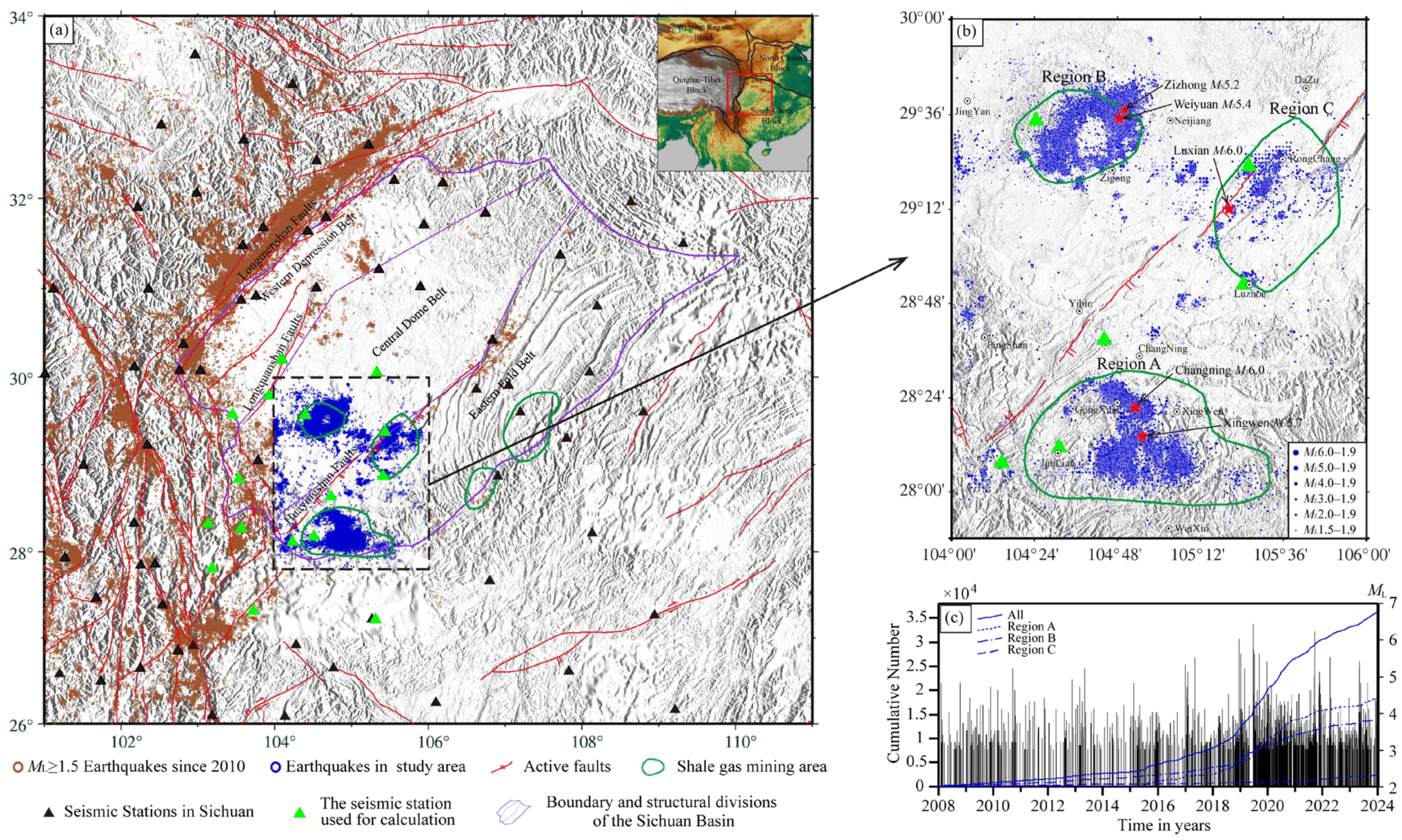
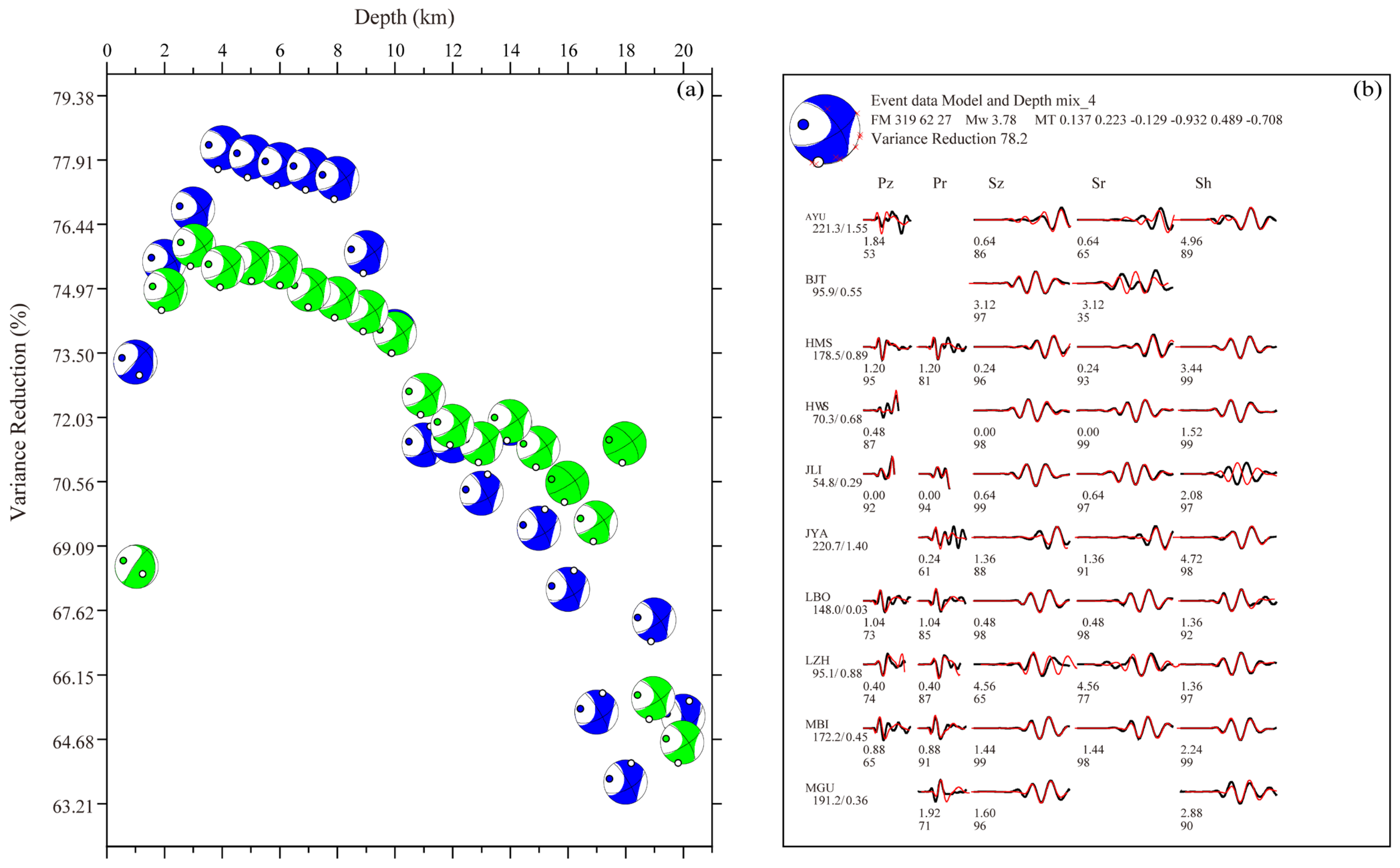
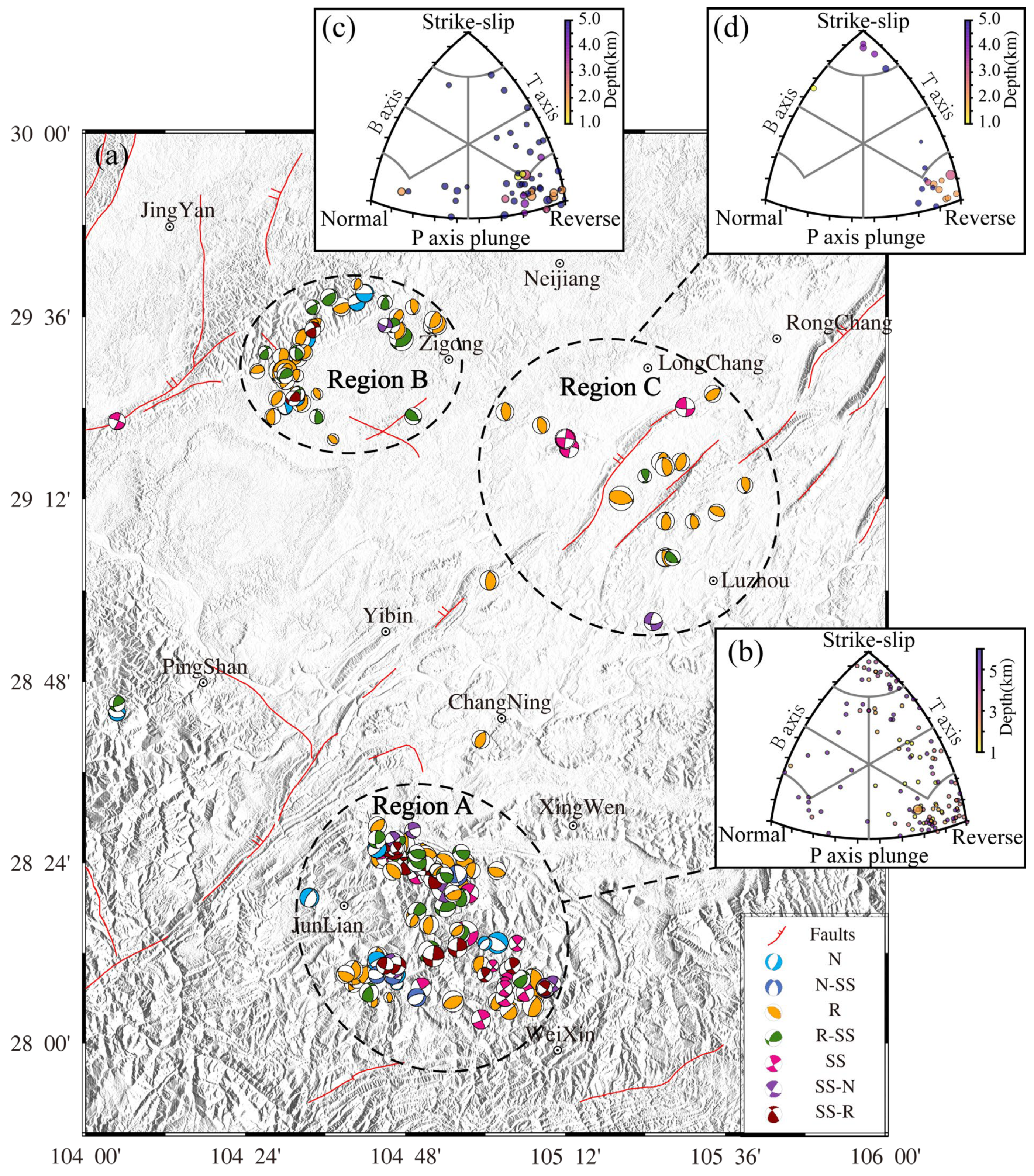
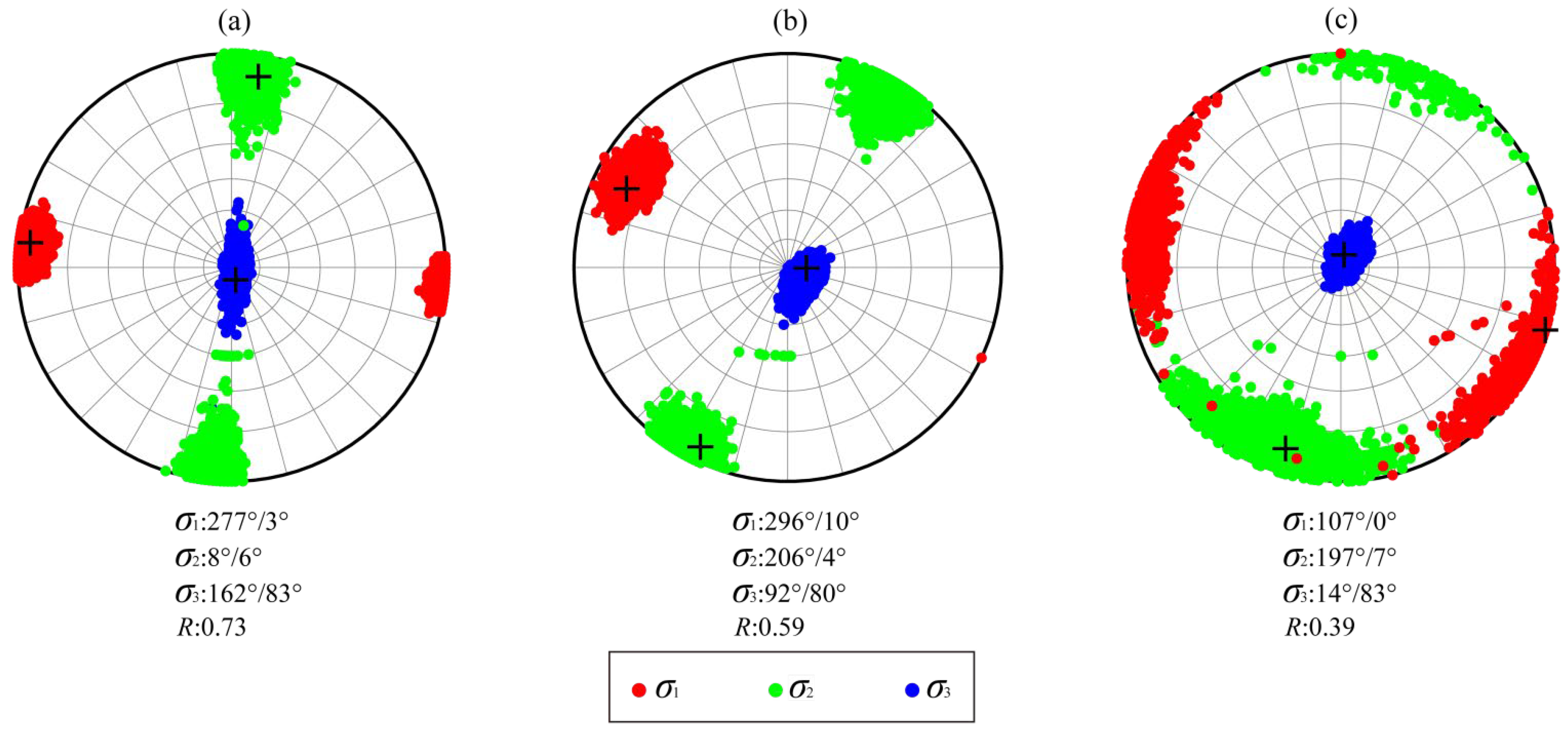


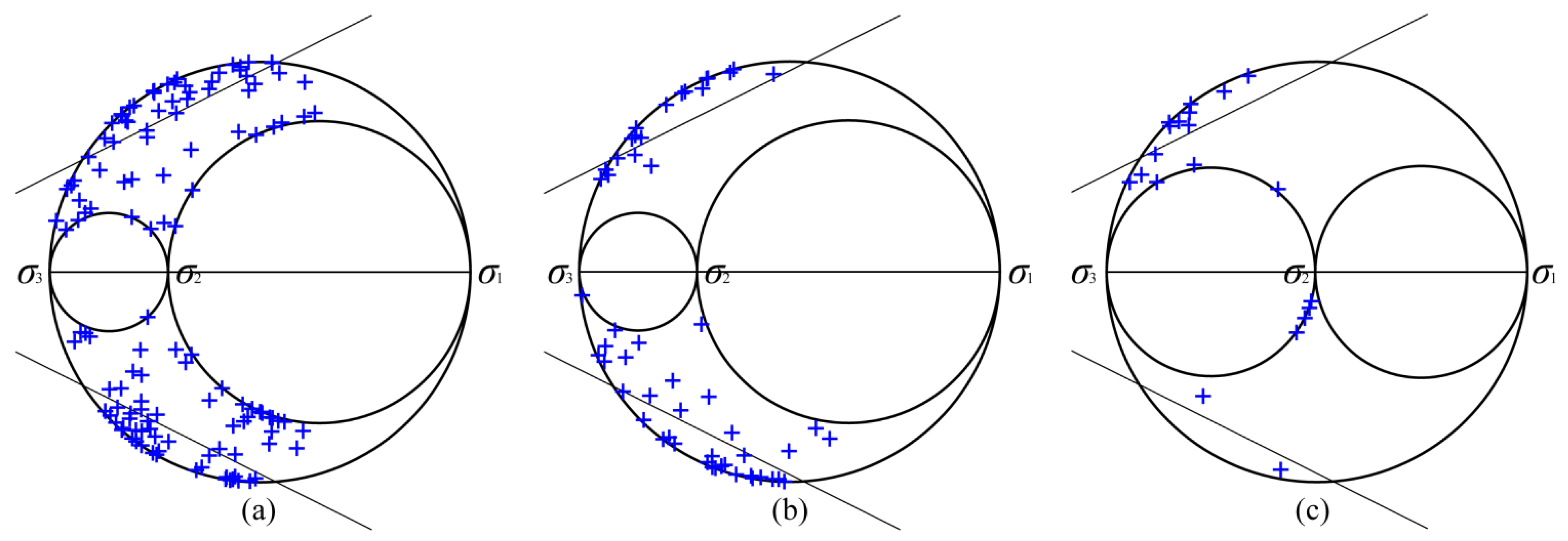
Disclaimer/Publisher’s Note: The statements, opinions and data contained in all publications are solely those of the individual author(s) and contributor(s) and not of MDPI and/or the editor(s). MDPI and/or the editor(s) disclaim responsibility for any injury to people or property resulting from any ideas, methods, instructions or products referred to in the content. |
© 2025 by the authors. Licensee MDPI, Basel, Switzerland. This article is an open access article distributed under the terms and conditions of the Creative Commons Attribution (CC BY) license (https://creativecommons.org/licenses/by/4.0/).
Share and Cite
Zhao, M.; Qi, Y.; Long, F.; Peng, L.; He, C.; Wang, D.; Ran, X. Characterization of the Solution of the Seismic Source Mechanism in Southeastern Sichuan. Appl. Sci. 2025, 15, 3881. https://doi.org/10.3390/app15073881
Zhao M, Qi Y, Long F, Peng L, He C, Wang D, Ran X. Characterization of the Solution of the Seismic Source Mechanism in Southeastern Sichuan. Applied Sciences. 2025; 15(7):3881. https://doi.org/10.3390/app15073881
Chicago/Turabian StyleZhao, Min, Yuping Qi, Feng Long, Liyuan Peng, Chang He, Di Wang, and Xiyang Ran. 2025. "Characterization of the Solution of the Seismic Source Mechanism in Southeastern Sichuan" Applied Sciences 15, no. 7: 3881. https://doi.org/10.3390/app15073881
APA StyleZhao, M., Qi, Y., Long, F., Peng, L., He, C., Wang, D., & Ran, X. (2025). Characterization of the Solution of the Seismic Source Mechanism in Southeastern Sichuan. Applied Sciences, 15(7), 3881. https://doi.org/10.3390/app15073881




